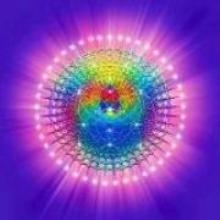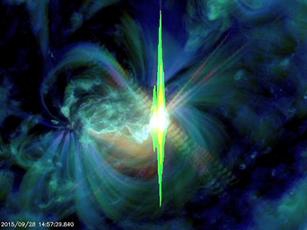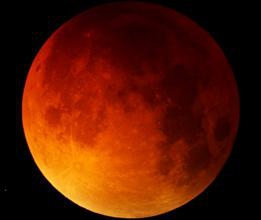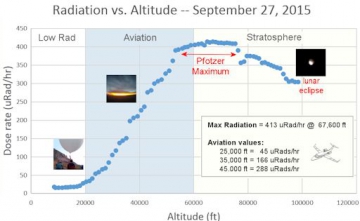30/09/2015
Grande activité solaire qui a causé des pannes en Amérique du Sud et dans l'Océan Atlantique
Source : http://spaceweather.com/index.php
Traduction Google : ICI
Marianne's Heaven On Earth Aurora Chaser Tours Chasethelighttours.co.uk invites you to join them in their quest to find and photograph the Aurora Borealis. Experience the winter wonderland in the Tromsø Area. 
![]()
MANY FLARES, FEW CMEs: Sunspot AR2422 is crackling with solar flares. The behemoth active region has produced more than 6 M-flares in the past 24 hours, inluding this intense M7.6 category explosion recorded by NASA's Solar Dynamics Observatory on Sept. 28th:
Extreme UV radiation from the flare ionized the top of Earth's atmosphere and caused a brief low-frequency radio blackout over South America and the Atlantic ocean: blackout map. Similar blackouts are occuring every few hours today as the flare activity continues. The frequencies most affected are below 10 MHz.
Despite this high solar activity, there have been no major CMEs. All of the flares have been brief and impulsive. Generally, CMEs require longer-lasting explosions.
AR2422 has an unstable 'beta-gamma-delta' magnetic field that could erupt again at any moment. NOAA forecasters estimate a 70% chance of additional M-class solar flares and a 25% chance of X-flares during the next 24 hours. Solar flare alerts: text or voice
WHAT MADE THE LUNAR ECLIPSE SO DARK? On Sunday night, Sept. 27th, the supermoon passed through the shadow of Earth, producing a total lunar eclipse visible from the Americas, Europe, Africa and parts of Asia. "It was one of the darkest lunar eclipses I have ever seen," reports Kevin R. Witman, who sends this picture from Cochranville, Pennsylvania:
Other observers (see the gallery) also remarked on the darker hue of this lunar eclipse, compared to others in recent years. What caused the change? Atmospheric scientist Richard Keen of the University of Colorado offers one reason: "Supermoon eclipses should be a bit darker. Because of its closeness to Earth, a supermoon passes deeper into the shadow of our planet."
Working independently, Steve Albers of NOAA and Helio Vital of REA/Brazil have suggested another reason: aerosols in the atmosphere.
"Earth's stratosphere is no longer completely clean of volcanic ashes," says Vital. "In fact, lingering aerosols from the explosion of Calbuco, five months ago, may be to blame for that excessive darkening."
Calbuco is a volcano in Chile. After it erupted in April 2015, colorful sunsets were observed around the southern hemisphere for months. Recently, Albers has noted an increase in purple and yellow sunsets around his home town, Boulder CO, and elsewhere. These are telltale colors of volcanic exhaust.
"A thin veneer of aerosols from Calbuco may have now spread to the northern hemisphere," Albers says. "In addition, we could be seeing the effects of residual smoke from forest fires at high altitudes, or the general increase in sulfate pollution that has been documented on a global basis."
Richard Keen, who is a leading expert on volcanic aerosols and lunar eclipses, says "the Sept. 27th eclipse was about 0.5 magnitudes darker than expected for a clear stratosphere. A slight layer of aerosols in the upper troposphere/lower stratosphere might explain this. Also, the Moon passed through the southern part of Earth's shadow, so southern hemisphere aerosols (such as those produced by Calbuco) would have greater effect."
Keen says that he is still "crunching the numbers," and we may have more information soon...
Realtime Eclipse Photo Gallery
COSMIC RAYS DURING THE LUNAR ECLIPSE: On the evening of Sept. 27th, Spaceweather.com and the students of Earth to Sky Calculus conducted a routine flight of their cosmic ray payload to the stratosphere. Routine, that is, except for one thing: the balloon flew at night during a lunar eclipse. One of the goals of the flight was to compare radiation levels at night to those recorded during the day. Here are the data they recorded:
Compare the Sept. 27th plot of radiation vs. altitude to a similar plot recorded in broad daylight only a few days earlier. In the stratosphere, radiation levels were the same to within 1%. At aviation altitudes, radiation levels were the same to within about 3%. There was no significant difference, night vs. day.
This simple experiment highlights something that is already well known to researchers. Cosmic rays in the atmosphere come mainly from deep space. They are accelerated toward Earth by supernovas, colliding neutron stars, and other violent events in the Milky Way. Flying at night is no safeguard against these energetic particles because they are everpresent, coming at us from all directions, day and night.
The payload also contained a unique biological radiation sensor consisting of multiple strains of yeast. Data from the microbes are still being reduced. Expect updates in a few days after the colonies have time to grow.
02:29 Publié dans Ascension du Système solaire, Astrologie - Astronomie | Lien permanent |  |
|  del.icio.us |
del.icio.us |  |
|  Imprimer |
Imprimer |  Digg |
Digg | ![]() Facebook | | |
Facebook | | |  |
|







Les commentaires sont fermés.